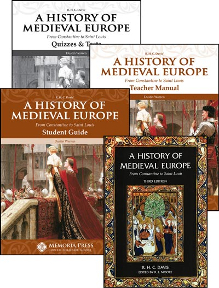A History of Medieval Europe is a year-long course that consists of a textbook by R.H.C. Davis titled A History of Medieval Europe: From Constantine to St. Louis (Third Edition), a student guide, a teacher manual, and a book of quizzes and tests. The textbook for this course was written for an adult audience, but it should work for average to advanced teens. The publisher, Memoria Press, recommends that this course be used by students in tenth grade and above.
The textbook focuses on key themes rather than trying to cover everything. The recurring key themes are the “legacy of Greece and Rome, the effects of barbarization, and the impact of Christianity” (A History of Medieval Europe: Teacher Manual, p. vi). These themes are centered around government (largely European rulers), religion (especially the Catholic Church), and society—the course refers to these as key structures.
Davis relates history as an ongoing story, making connections so that the reader can make sense of historical events. He explains, for instance, how the popes became temporal rulers, how and why the feudal system came into existence, why the frequent tension between rulers and popes was important, how St. Francis of Assisi contributed to the reform of the Catholic Church, and why he also came into frequent conflict with church leadership. One story leads to another as Davis portrays the people, events, and ideas that shaped the medieval period. While it is not a Catholic text, it has extensive coverage of developments related to Catholicism and generally presents a positive view of the Catholic Church.
There are 17 chapters in the text. The teacher manual and student guide present chapter-by-chapter lesson activities and follow the same basic format for each chapter. Dustin Warren, author of the teacher manual and the student guide, explains how the course should be taught by a teacher who is able to present lectures and guide discussions. Since that is his expectation of how the course will be used, Warren provides valuable assistance for group class teachers by outlining their lesson presentations for them. He begins with a “hook” question to engage students’ interest. He also presents an outline of key points that should be covered, sometimes adding material not in the text, and clearly reinforcing the connections between events. Teachers still need to do some preparation work, but Warren makes it much easier.
The course is also useful for independent study for students who will diligently read the text on their own. Some discussion will still be helpful for independent learners, but the course will still be worthwhile even if students only read the textbook and answer the questions on their own.
The student guide helps focus the student's attention on key information and ideas. Students should read each chapter before working in the student guide, but they might want to look over the questions before doing their reading.
The first activity in the student guide is to write a brief summary of the main idea of the chapter. The hook question is presented next for students to either answer or consider on their own if there is no lecture. Discussion is best for the hook questions because they often involve subjective answers and opinions that can lead to great discussions.
After the hook question, students are given key terms, key figures, key dates, and key structures to define or explain. For example, they might have terms like "Metropolitan" and "Cenobitic" to define, people such as St. Benedict and Gregory the Great to identify, and a date (or year) for which they will write in a critical event that occurred. For each chapter, students will write a brief summary of how each of the key structures (government, religion, and society) “changed, experienced alteration, or encountered difficulty.”
Next in the student guide is a series of ten or more comprehension questions. Many of these questions ask students to explain, outline, or describe, so, to answer correctly, students must assimilate the material they have read and usually write more than one sentence in response. One or two short-answer essay questions follow the comprehension questions, and students are to respond with essays of five to eight sentences. One example reads: “Based on this chapter, compare and contrast the beliefs of Christianity and Islam” (p. 30). Students will also do timeline and map work for most chapters. If a student doesn’t have time to complete all of this work, the teacher manual has a section within each lesson, “Questions to Mark for the Test,” that lists the most important terms, people, dates, and questions for which students need to write responses. This helps teachers know how to reduce the student workload if they need to.
Quizzes for the 17 chapters and four tests are in a separate book. The answers for both the chapter activities in the student guide and the quizzes and tests are in the teacher manual.
The A History of Medieval Europe course is outstanding because it teaches students historical facts while helping them understand the ever-present conflicts between government and religion as they vie for power and influence within each culture. This is the type of knowledge that helps students better understand modern-day cultural battles.









